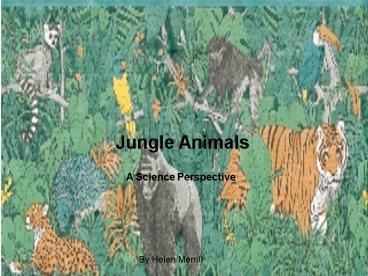Jungle Animals PowerPoint PPT Presentation
1 / 11
Title: Jungle Animals
1
Jungle Animals
A Science Perspective
By Helen Merrill
2
- Life in the jungle is filled with danger. Cougars
and pumas stand ready to pounce snakes sliver
unseen between feet to administer a lethal bite
while exotic birds chirp overhead. An animal must
be both smart and strong to survive in this
environment. The intense competition from other
species makes jungle animals the most
interesting. The jungles of the world are being
destroyed by loggers and development. Many
species found in the rainforest are endangered.
Once they disappear, they are gone forever!
3
Animal Classification
Jungle animals can be classified into these
different groups
4
Mammals
- Mammals are vertebrate animals with body hair,
mammary glands and four limbs. They breathe air
and are warm-blooded. They have a four-chambered
heart. The young are born alive and feed on their
mothers milk. The largest animals, the elephant
and the whale, are mammals,.
5
Birds
- Birds are warm-blooded, air-breathing vertebrates
with a four chambered heart that are covered with
feathers. They reproduce by laying eggs. They
have a light body weight in relation to their
size.
6
Amphibians
- Amphibians are the earliest form of all land
vertebrates. The word amphibia means both
lives. These animals begin life in the water,
spend their adult life on land, and return to the
water to lay their eggs. They are born with gills
to breathe under water. These are replaced by
lungs at the end of their development, or
metamorphosis, into adults, They lay eggs.
7
Reptiles
- Reptiles are cold-blooded and breathe air. Their
skin is thick, usually forming scales or plates.
Their young develop in eggs, inside or outside
the body, depending on the species.
8
Fish
- Fish live in water all their lives. They breathe
oxygen from water through special organs called
gills. They have fins and scales. Fish are
cold-blooded and give birth to babies hatched
from eggs.
9
Insects and Spiders
- Insects and spiders are known as arthropods.
They have segmented bodies, jointed legs, and an
external skeleton. There are more than a million
species of insects and around 50,000 species of
spiders, scorpions, mites and ticks. They are
cold-blooded and give birth to young hatched from
eggs.
10
Habitat
- A habitat is an environment where the existing
conditions meet the needs of a form of wildlife
for survival. The setting is determined by the
geology of the land and the climate. These
factors influence the vegetation, which in turn
defines the animal inhabitants.
11
Resources
- Wildlife Fact File, 1995
- http//junglewalk.com/
- http//mbgnet.mobot.org/sets/rforest/animals/
- http//www.junglephotos.com/

